Mapping Essential Urban Land Use Categories in Nanjing by Integrating Multi-Source Big Data
Abstract
:1. Introduction
2. Materials and Methods
2.1. Study Area
2.2. Data and Sources
2.2.1. Remotely Sensed Data
Sentinel-2A/B Composite Imagery
Luojia-1 Nighttime Light Image
Google Earth High-Resolution Image
2.2.2. Social Media Data
Point of Interest
Mobile Phone Locating-Request Big Data
2.2.3. Other Data
The Impervious Surface
OSM Road Network
Building Footprint Dataset
FROM-GLC10
2.3. Methods
2.3.1. Classification System
2.3.2. Parcels Generation
2.3.3. POIs Processing
2.3.4. Features Extraction
From Remote Sensing Data
From POIs
From the Building Footprint Data
From Mobile Phone Locating-Request Big Data
2.3.5. Urban Land Use Classification
3. Results
3.1. The Results of POI Regeneration
3.2. Feature Selection
3.3. Performance of EULUC-Nanjing
4. Discussion
4.1. Contribution of Different Features
4.2. The Impact of the Sample Sizes
5. Conclusions
Supplementary Materials
Author Contributions
Funding
Acknowledgments
Conflicts of Interest
References
- The World Bank. Available online: https://www.worldbank.org/en/topic/urbandevelopment/overview (accessed on 16 July 2020).
- United Nations. Available online: https://www.un.org/en/climatechange/cities-pollution.shtml (accessed on 16 July 2020).
- Arsanjani, J.J.; Helbich, M.; Bakillah, M.; Hagenauer, J.; Zipf, A. Toward mapping land-use patterns from volunteered geographic information. Int. J. Geogr. Inf. Sci. 2013, 27, 2264–2278. [Google Scholar] [CrossRef]
- Fisher, P. The pixel: A snare and a delusion. Int. J. Remote Sens. 1997, 18, 679–685. [Google Scholar] [CrossRef]
- Lu, D.; Weng, Q. Use of impervious surface in urban land-use classification. Remote Sens. Environ. 2006, 102, 146–160. [Google Scholar] [CrossRef]
- Shaban, M.; Dikshit, O. Improvement of classification in urban areas by the use of textural features: The case study of Lucknow city, Uttar Pradesh. Int. J. Remote Sens. 2001, 22, 565–593. [Google Scholar] [CrossRef]
- Wu, S.-S.; Qiu, X.; Usery, E.L.; Wang, L. Using geometrical, textural, and contextual information of land parcels for classification of detailed urban land use. Ann. Assoc. Am. Geogr. 2009, 99, 76–98. [Google Scholar] [CrossRef]
- Voltersen, M.; Berger, C.; Hese, S.; Schmullius, C. Object-based land cover mapping and comprehensive feature calculation for an automated derivation of urban structure types at block level. Remote Sens. Environ. 2014, 154, 192–201. [Google Scholar] [CrossRef]
- Hu, T.; Yang, J.; Li, X.; Gong, P. Mapping Urban Land Use by Using Landsat Images and Open Social Data. Remote Sens. 2016, 8, 151. [Google Scholar] [CrossRef]
- Yuan, J.; Zheng, Y.; Xie, X. Discovering regions of different functions in a city using human mobility and POIs. In Proceedings of the 18th ACM SIGKDD International Conference on Knowledge Discovery and Data Mining, Beijing, China, 12–16 August 2012; pp. 186–194. [Google Scholar]
- Liu, X.; Long, Y. Automated identification and characterization of parcels with OpenStreetMap and points of interest. Environ. Plan. B Plan. Des. 2016, 43, 341–360. [Google Scholar] [CrossRef]
- Gong, P.; Chen, B.; Li, X.; Liu, H.; Wang, J.; Bai, Y.; Chen, J.; Chen, X.; Fang, L.; Feng, S.; et al. Mapping essential urban land use categories in China (EULUC-China): Preliminary results for 2018. Sci. Bull. 2020, 65, 182–187. [Google Scholar] [CrossRef] [Green Version]
- Zhang, X.; Li, P.; Cai, C. Regional urban extent extraction using multi-sensor data and one-class classification. Remote Sens. 2015, 7, 7671–7694. [Google Scholar] [CrossRef] [Green Version]
- Jia, Y.; Ge, Y.; Ling, F.; Guo, X.; Wang, J.; Wang, L.; Chen, Y.; Li, X. Urban Land Use Mapping by Combining Remote Sensing Imagery and Mobile Phone Positioning Data. Remote Sens. 2018, 10, 446. [Google Scholar] [CrossRef] [Green Version]
- Li, X.; Zhao, L.; Li, D.; Xu, H. Mapping Urban Extent Using Luojia 1-01 Nighttime Light Imagery. Sensors 2018, 18, 3665. [Google Scholar] [CrossRef] [PubMed] [Green Version]
- Zhang, X.; Du, S.; Wang, Q. Hierarchical semantic cognition for urban functional zones with VHR satellite images and POI data. ISPRSJ. Photogramm. Remote Sens. 2017, 132, 170–184. [Google Scholar] [CrossRef]
- Chen, B.; Song, Y.; Huang, B.; Xu, B. A novel method to extract urban human settlements by integrating remote sensing and mobile phone locations. Sci. Remote Sens. 2020, 100003. [Google Scholar] [CrossRef]
- Chen, B.; Song, Y.; Jiang, T.; Chen, Z.; Huang, B.; Xu, B. Real-Time Estimation of Population Exposure to PM2.5 Using Mobile- and Station-Based Big Data. Int. J. Env. Res. Public Health 2018, 15, 573. [Google Scholar] [CrossRef] [Green Version]
- Niu, N.; Liu, X.; Jin, H.; Ye, X.; Liu, Y.; Li, X.; Chen, Y.; Li, S. Integrating multi-source big data to infer building functions. Int. J. Geogr. Inf. Sci. 2017, 31, 1871–1890. [Google Scholar] [CrossRef]
- Tang, J.; Liu, F.; Wang, Y.; Wang, H. Uncovering urban human mobility from large scale taxi GPS data. Phys. A Stat. Mech. Its Appl. 2015, 438, 140–153. [Google Scholar] [CrossRef]
- Hobel, H.; Abdalla, A.; Fogliaroni, P.; Frank, A.U. A semantic region growing algorithm: Extraction of urban settings. In AGILE 2015; Springer: Cham, Switzerland, 2015; pp. 19–33. [Google Scholar]
- Yao, Y.; Li, X.; Liu, X.; Liu, P.; Liang, Z.; Zhang, J.; Mai, K. Sensing spatial distribution of urban land use by integrating points-of-interest and Google Word2Vec model. Int. J. Geogr. Inf. Sci. 2016, 31, 825–848. [Google Scholar] [CrossRef]
- Ge, P.; He, J.; Zhang, S.; Zhang, L.; She, J. An Integrated Framework Combining Multiple Human Activity Features for Land Use Classification. ISPRS Int. J. Geo-Inf. 2019, 8, 90. [Google Scholar] [CrossRef] [Green Version]
- Gong, P.; Li, X.; Zhang, W. 40-Year (1978–2017) human settlement changes in China reflected by impervious surfaces from satellite remote sensing. Sci. Bull. 2019, 64, 756–763. [Google Scholar] [CrossRef] [Green Version]
- Gong, P.; Liu, H.; Zhang, M.; Li, C.; Wang, J.; Huang, H.; Clinton, N.; Ji, L.; Li, W.; Bai, Y.; et al. Stable classification with limited sample: Transferring a 30-m resolution sample set collected in 2015 to mapping 10-m resolution global land cover in 2017. Sci. Bull. 2019, 64, 370–373. [Google Scholar] [CrossRef] [Green Version]
- Tu, Y.; Chen, B.; Zhang, T. Regional Mapping of Essential Urban Land Use Categories in China: A Segmentation-Based Approach. Remote Sens. 2020, 12, 1058. [Google Scholar] [CrossRef] [Green Version]
- Liu, S.; Qi, Z.; Li, X.; Yeh, A.G.-O. Integration of convolutional neural networks and object-based post-classification refinement for land use and land cover mapping with optical and sar data. Remote Sens. 2019, 11, 690. [Google Scholar] [CrossRef] [Green Version]
- Gong, P.; Marceau, D.J.; Howarth, P.J. A comparison of spatial feature extraction algorithms for land-use classification with SPOT HRV data. Remote Sens. Environ. 1992, 40, 137–151. [Google Scholar] [CrossRef]
- Nanjing Municipal Bureau Statistics. Available online: http://221.226.86.104/file/2018/renkou/3-8.htm (accessed on 16 July 2020).
- Lisle, R.J. Google Earth: A new geological resource. Geol. Today 2006, 22, 29–32. [Google Scholar] [CrossRef]
- Li, X.; Gong, P. An “exclusion-inclusion” framework for extracting human settlements in rapidly developing regions of China from Landsat images. Remote Sens. Environ. 2016, 186, 286–296. [Google Scholar] [CrossRef]
- Haklay, M.; Weber, P. Openstreetmap: User-generated street maps. IEEE Pervasive Comput. 2008, 7, 12–18. [Google Scholar] [CrossRef] [Green Version]
- Mikolov, T.; Chen, K.; Corrado, G.; Dean, J. Efficient estimation of word representations in vector space. arXiv 2013, arXiv:1301.3781. [Google Scholar]
- Duan, Y.; Liu, Y.; Liu, X.; Wang, H. Identification of polycentric urban structure of central Chongqing using points of interest big data. J. Nat. Resour. 2018, 33, 70–82. [Google Scholar]
- Kohavi, R. A study of cross-validation and bootstrap for accuracy estimation and model selection. IJCAI 1995, 14, 1137–1145. [Google Scholar]
- Breiman, L. Random forests. Mach. Learn. 2001, 45, 5–32. [Google Scholar] [CrossRef] [Green Version]
- Rodriguez-Galiano, V.F.; Ghimire, B.; Rogan, J.; Chica-Olmo, M.; Rigol-Sanchez, J.P. An assessment of the effectiveness of a random forest classifier for land-cover classification. ISPRS J. Photogramm. Remote Sens. 2012, 67, 93–104. [Google Scholar] [CrossRef]
- Kuhn, M. Building predictive models in R using the caret package. J. Stat. Softw. 2008, 28, 1–26. [Google Scholar] [CrossRef] [Green Version]
- Alberg, A.J.; Park, J.W.; Hager, B.W. The use of “overall accuracy” to evaluate the validity of screening or diagnostic tests. J. Gen. Intern. Med. 2004, 19, 460–465. [Google Scholar] [CrossRef] [Green Version]
- Cohen, J. A coefficient of agreement for nominal scales. Educ. Psychol. Meas. 1960, 20, 37–46. [Google Scholar] [CrossRef]
- Kraemer, H.C. Kappa coefficient. Wiley Statsref Stat. Ref. Online 2014, 1–4. [Google Scholar]
- Wang, Y.P.; Wang, Y.; Wu, J. Urbanization and informal development in China: Urban villages in Shenzhen. Int. J. Urban Reg. Res. 2009, 33, 957–973. [Google Scholar] [CrossRef]
- Liu, X.; Niu, N.; Liu, X. Characterizing mixed-use buildings based on multi-source big data. Int. J. Geogr. Inf. Sci. 2018, 32, 738–756. [Google Scholar] [CrossRef]
- Chen, Y.; Liu, X.; Li, X.; Liu, X.; Yao, Y.; Hu, G.; Xu, X.; Pei, F. Delineating urban functional areas with building-level social media data: A dynamic time warping (DTW) distance based k-medoids method. Landsc. Urban Plan. 2017, 160, 48–60. [Google Scholar] [CrossRef]
- Liu, X.; He, J.; Yao, Y.; Zhang, J.; Liang, H.; Wang, H.; Hong, Y. Classifying urban land use by integrating remote sensing and social media data. Int. J. Geogr. Inf. Sci. 2017, 31, 1675–1696. [Google Scholar] [CrossRef]


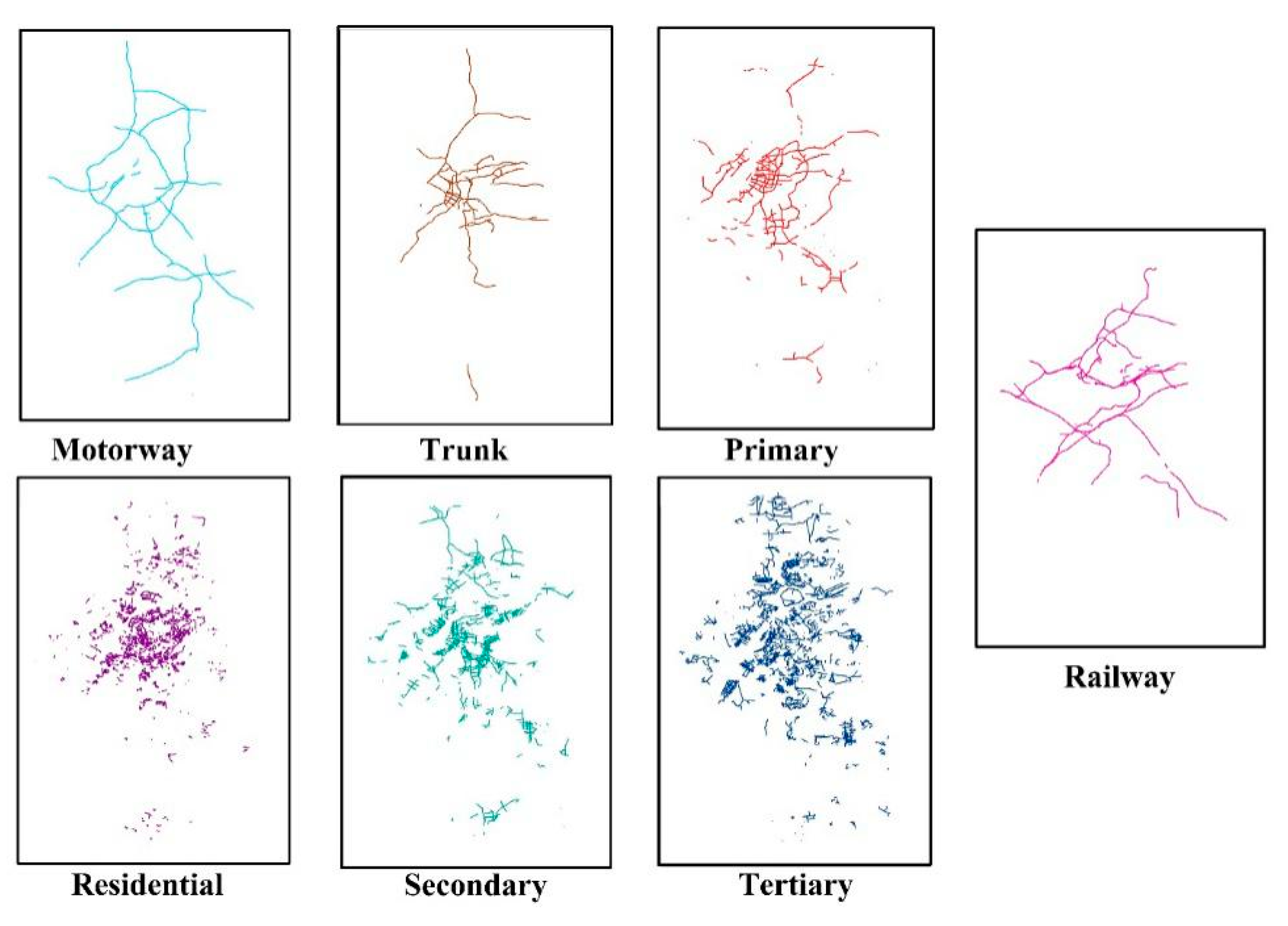
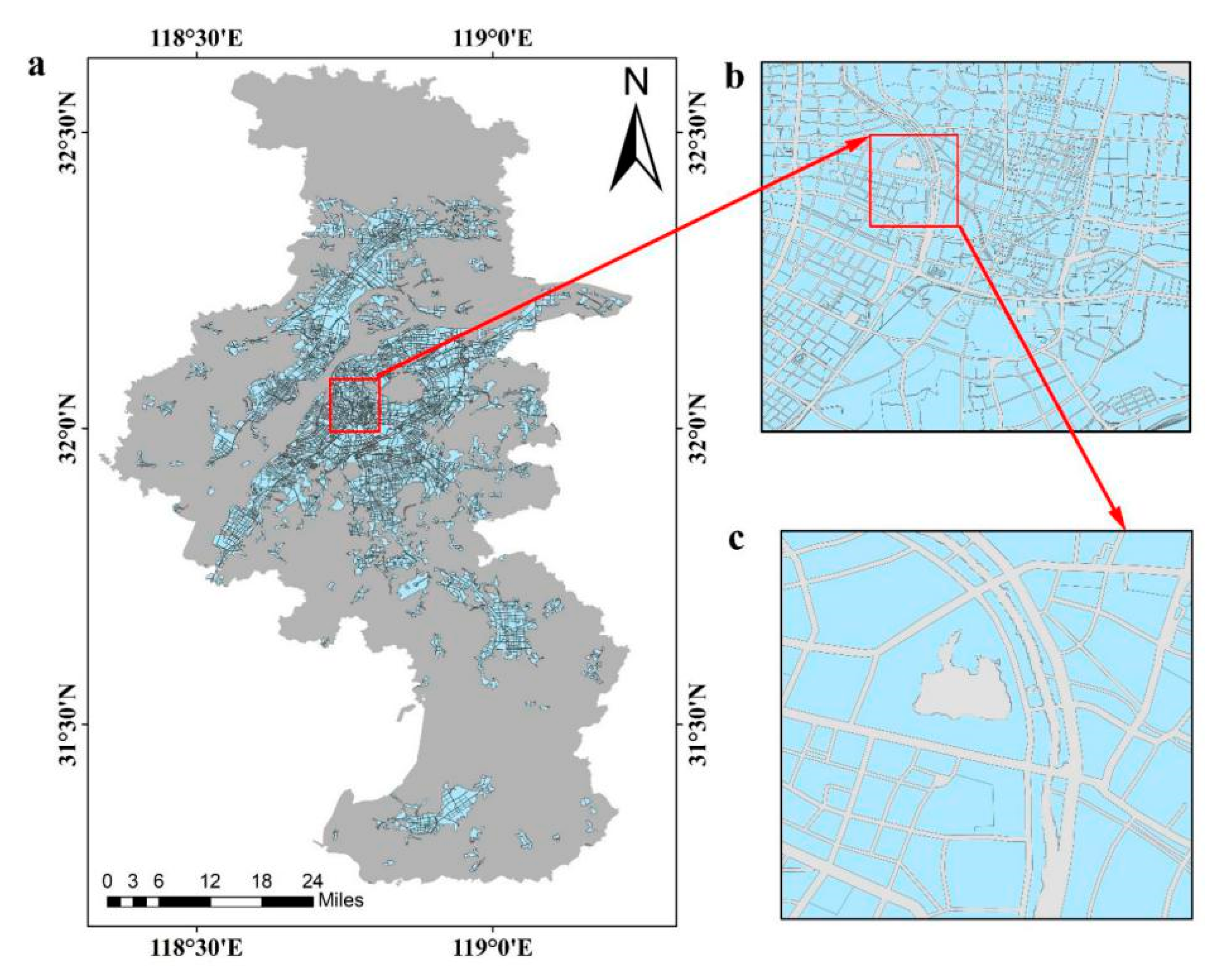
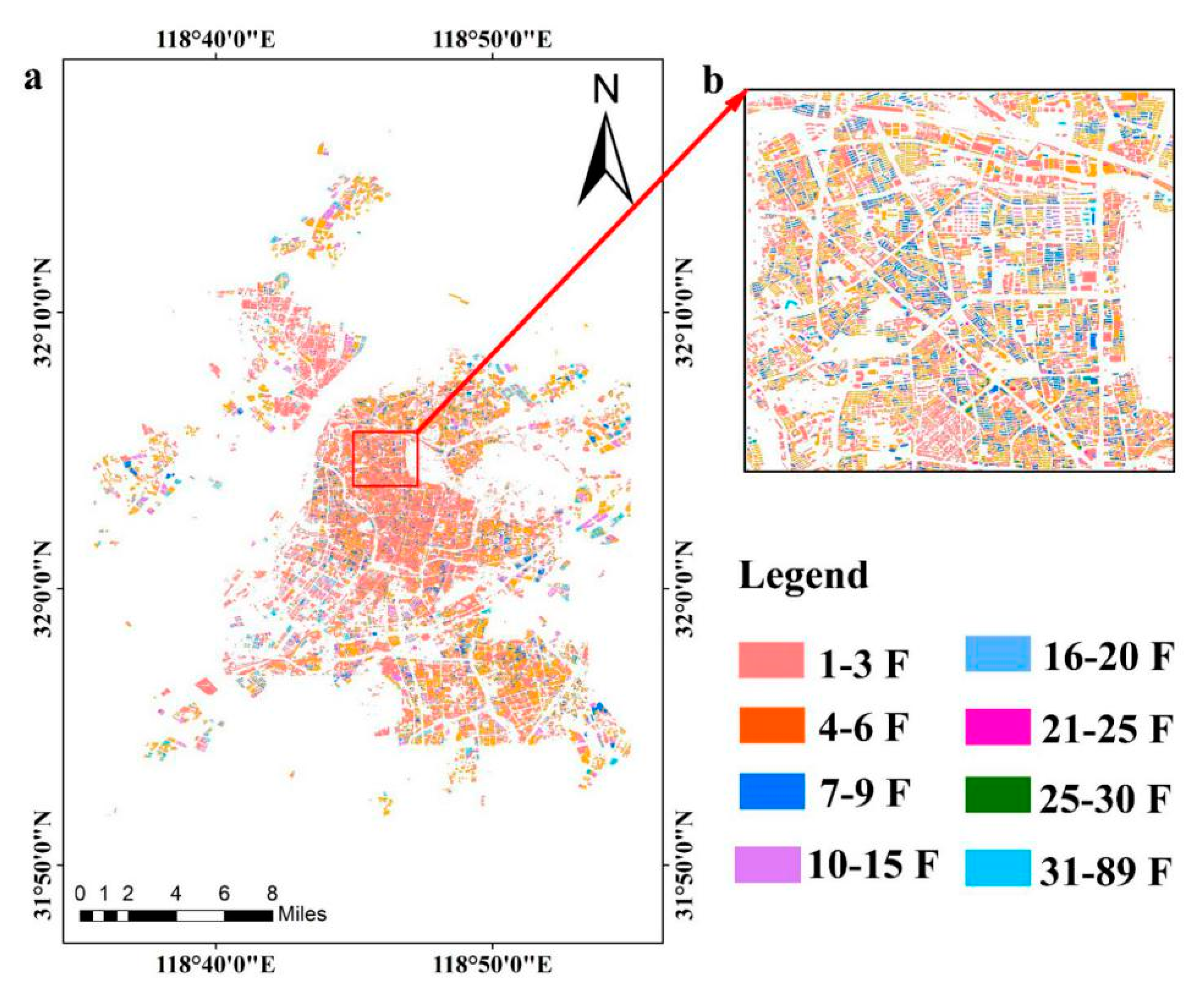


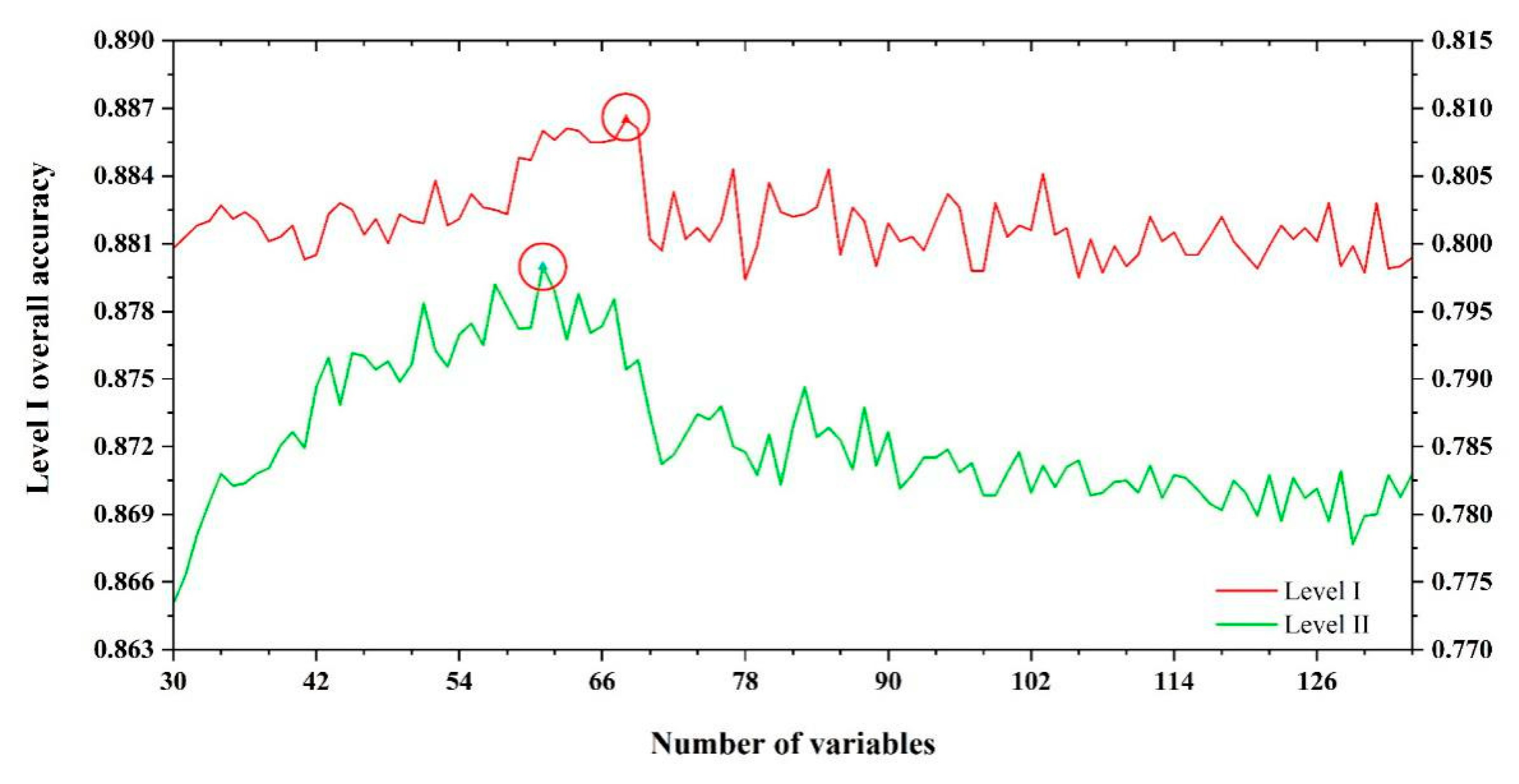

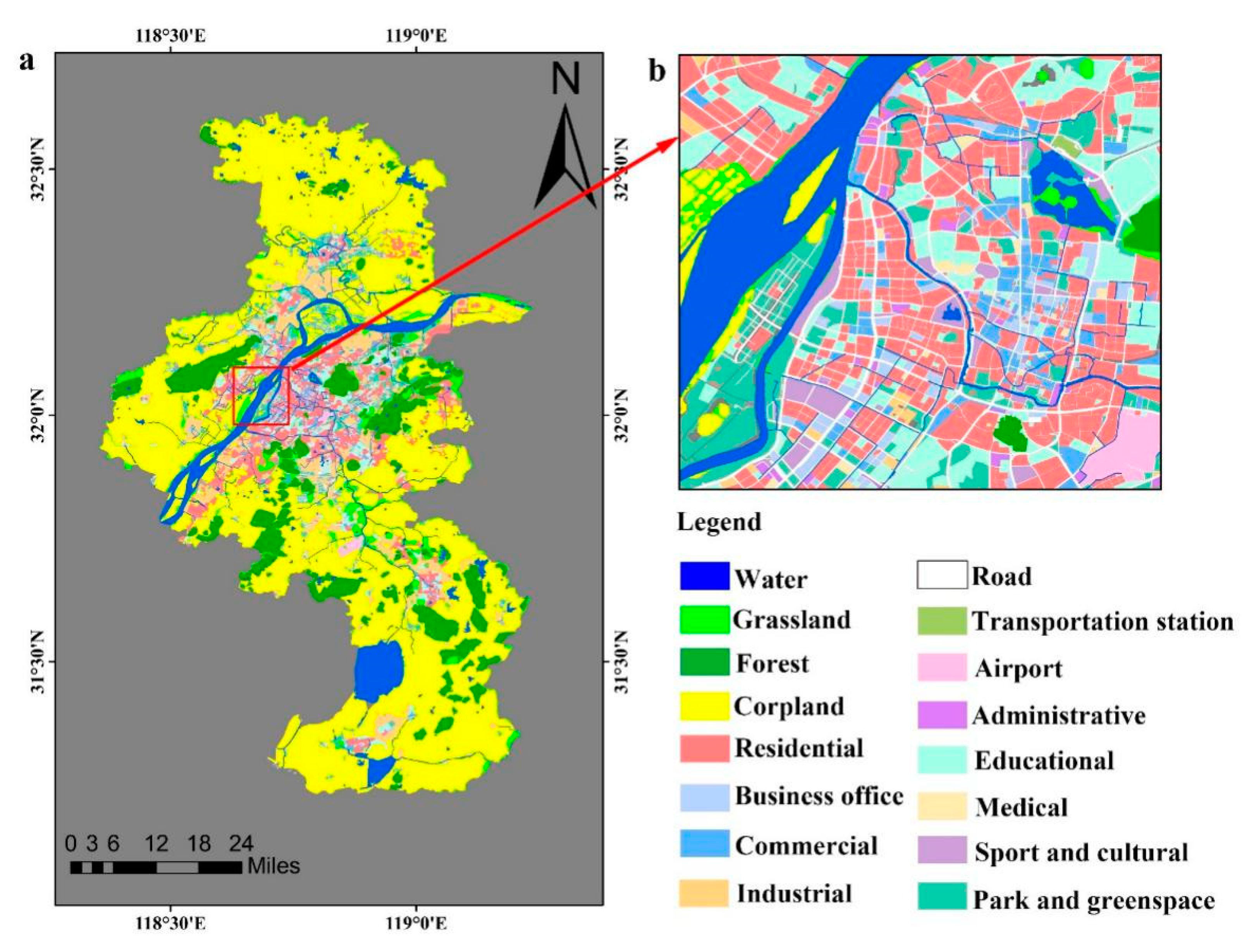
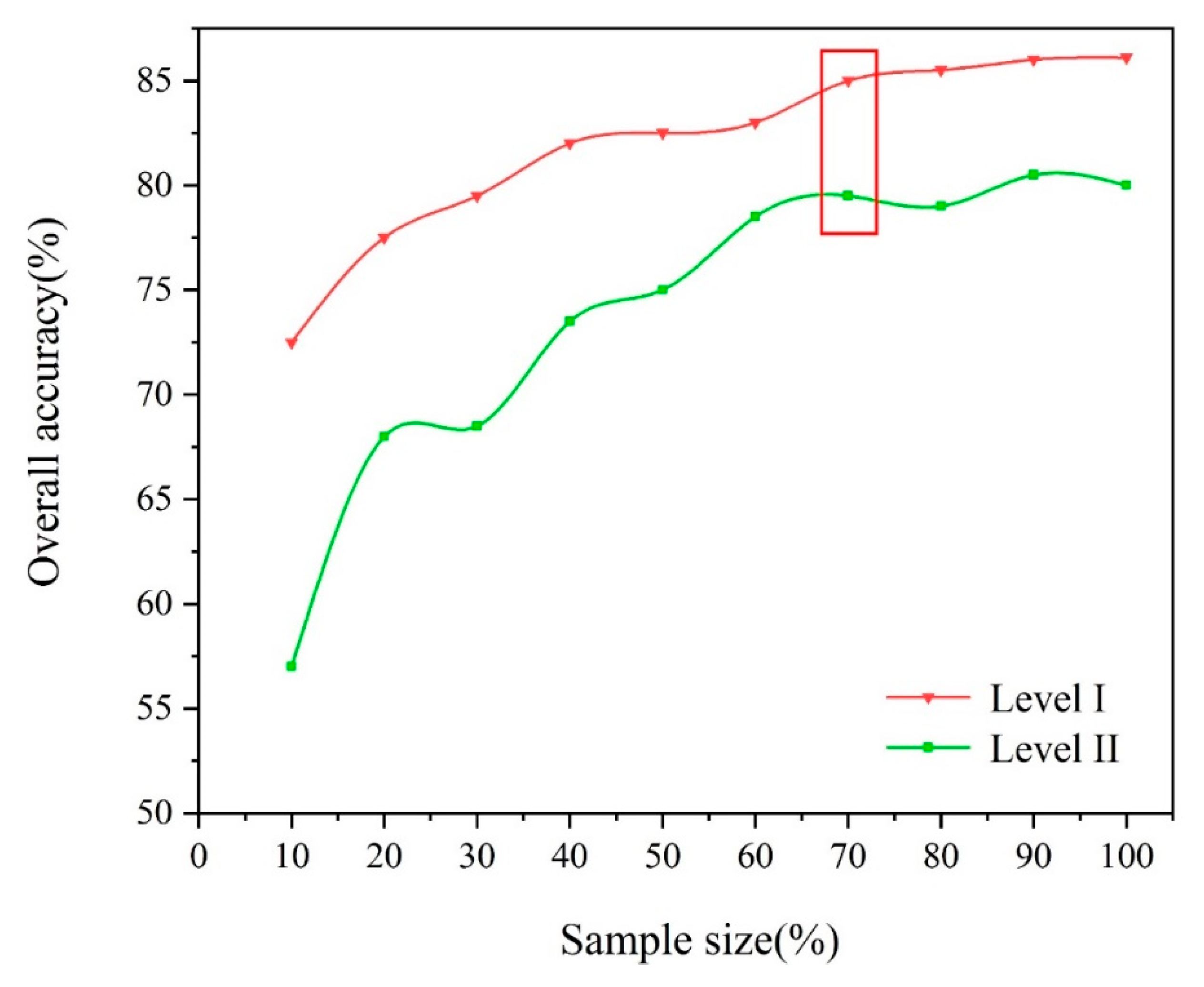
| Level | Primary | Secondary | Tertiary | Residential | Motorway | Trunk | Railway |
|---|---|---|---|---|---|---|---|
| Buffer thresholds | 44 m | 34.8 m | 30.4 m | 21.5 m | 42 m | 60.5 m | 7.7 m |
| Data | Features |
|---|---|
| Sentinel-2 (44) | Spectral features (18): Mean and standard deviation of blue, green, red, near-infrared, short-wave-infrared bands (band11,12), NDVI, NDBI, and NDWI. |
| Textural features (26): Entropy, contrast and correlation of blue, green, red, and near-infrared bands. Entropy of NDVI. | |
| Luojia-1 (1) | Mean of digital number values. |
| POIs (29) | Frequency features (19): Total number of all POIs, total number and proportion of each type of POIs within each parcel. |
| Spatial features (10): Spatial distribution of POIs. | |
| MPL (48) | Mean of hourly active population during weekdays and weekends. |
| Building footprint data (12) | Total number of buildings, proportion of different grade buildings, average height of buildings in each parcel, floor area ratio, and height density index. |
| Level I | Level II | Original | Regenerated |
|---|---|---|---|
| 01 Residential | 0101 Residential | 60,341 | 82,770 |
| 02 Commercial | 0201 Business office | 25,802 | 25,802 |
| 0202 Commercial service | 91,038 | 81,702 | |
| 03 Industrial | 0301 Industrial | 2594 | 13,961 |
| 05 Public | 0501 Administrative | 10,524 | 17,142 |
| 0502 Educational | 9591 | 14,805 | |
| 0503 Medical | 8049 | 11,498 | |
| 0504 Sport and cultural | 5827 | 8434 | |
| 0505 Park and greenspace | 2554 | 7685 |
| No. of Features | Level I | Level II | ||
|---|---|---|---|---|
| OA | Kappa Coefficient | OA | Kappa Coefficient | |
| 134 | 83.5% | 0.74 | 76% | 0.73 |
| 68 | 86.1% | 0.78 | - | - |
| 61 | - | - | 80% | 0.77 |
| OA: 86.1% | Kappa Coefficient: 0.78 | ||||||
|---|---|---|---|---|---|---|---|
| Level I | Residential | Commercial | Industrial | Public | Total | UA | PA |
| Residential | 20 | 1 | 0 | 4 | 25 | 80% | 83% |
| Commercial | 3 | 27 | 1 | 9 | 40 | 68% | 87% |
| Industrial | 0 | 0 | 22 | 3 | 25 | 88% | 96% |
| Public | 1 | 3 | 0 | 86 | 90 | 96% | 84% |
| Total | 24 | 31 | 23 | 102 | 180 | ||
| OA: 80% | Kappa Coefficient: 0.77 | |||||||||||
|---|---|---|---|---|---|---|---|---|---|---|---|---|
| Residential | Business | Commercial | Industrial | Administrative | Educational | Medical | Sport | Greenspace | Total | UA | PA | |
| Residential | 22 | 1 | 1 | 0 | 0 | 1 | 0 | 0 | 0 | 25 | 88% | 81% |
| Business | 1 | 9 | 3 | 1 | 1 | 0 | 0 | 0 | 0 | 15 | 60% | 64% |
| Commercial | 0 | 2 | 20 | 0 | 1 | 1 | 0 | 0 | 1 | 25 | 80% | 71% |
| Industrial | 1 | 0 | 0 | 23 | 0 | 1 | 0 | 0 | 0 | 25 | 92% | 92% |
| Administrative | 0 | 0 | 2 | 0 | 12 | 0 | 0 | 1 | 0 | 15 | 80% | 75% |
| Educational | 1 | 0 | 0 | 1 | 0 | 20 | 1 | 1 | 1 | 25 | 80% | 76% |
| Medical | 0 | 1 | 2 | 0 | 1 | 0 | 11 | 0 | 0 | 15 | 73% | 91% |
| Sport | 1 | 1 | 0 | 0 | 0 | 0 | 0 | 12 | 1 | 15 | 80% | 86% |
| Greenspace | 1 | 0 | 0 | 0 | 1 | 3 | 0 | 0 | 15 | 20 | 75% | 83% |
| Total | 27 | 14 | 28 | 25 | 16 | 26 | 12 | 14 | 18 | 180 | ||
| 0101 | 0201 | 0202 | 0301 | 0501 | 0502 | 0503 | 0504 | 0505 | |
| All features (134) | 88% | 67% | 72% | 96% | 62.5% | 75% | 73% | 67% | 75% |
| POI | 88% | 46% | 52% | 96% | 15% | 58% | 33% | 35% | 70% |
| Building height | 88% | 62% | 58.9% | 96% | 62.5% | 75% | 73% | 67% | 70% |
| MPL | 88% | 67% | 76% | 92% | 68% | 75% | 73% | 67% | 75% |
| Luojia-1 | 88% | 55% | 67% | 96% | 62.5% | 71% | 67% | 67% | 75% |
| Sentinel-2 | 80% | 64.9% | 68% | 86% | 62.5% | 71% | 73% | 67% | 60% |
© 2020 by the authors. Licensee MDPI, Basel, Switzerland. This article is an open access article distributed under the terms and conditions of the Creative Commons Attribution (CC BY) license (http://creativecommons.org/licenses/by/4.0/).
Share and Cite
Sun, J.; Wang, H.; Song, Z.; Lu, J.; Meng, P.; Qin, S. Mapping Essential Urban Land Use Categories in Nanjing by Integrating Multi-Source Big Data. Remote Sens. 2020, 12, 2386. https://doi.org/10.3390/rs12152386
Sun J, Wang H, Song Z, Lu J, Meng P, Qin S. Mapping Essential Urban Land Use Categories in Nanjing by Integrating Multi-Source Big Data. Remote Sensing. 2020; 12(15):2386. https://doi.org/10.3390/rs12152386
Chicago/Turabian StyleSun, Jing, Hong Wang, Zhenglin Song, Jinbo Lu, Pengyu Meng, and Shuhong Qin. 2020. "Mapping Essential Urban Land Use Categories in Nanjing by Integrating Multi-Source Big Data" Remote Sensing 12, no. 15: 2386. https://doi.org/10.3390/rs12152386
APA StyleSun, J., Wang, H., Song, Z., Lu, J., Meng, P., & Qin, S. (2020). Mapping Essential Urban Land Use Categories in Nanjing by Integrating Multi-Source Big Data. Remote Sensing, 12(15), 2386. https://doi.org/10.3390/rs12152386






